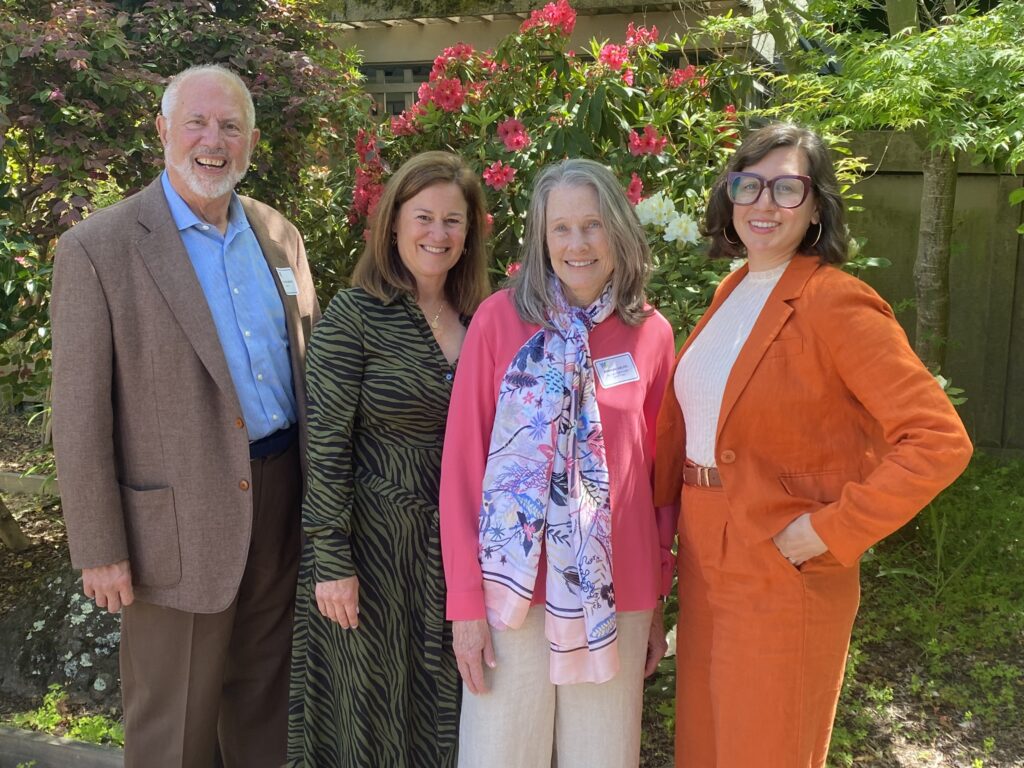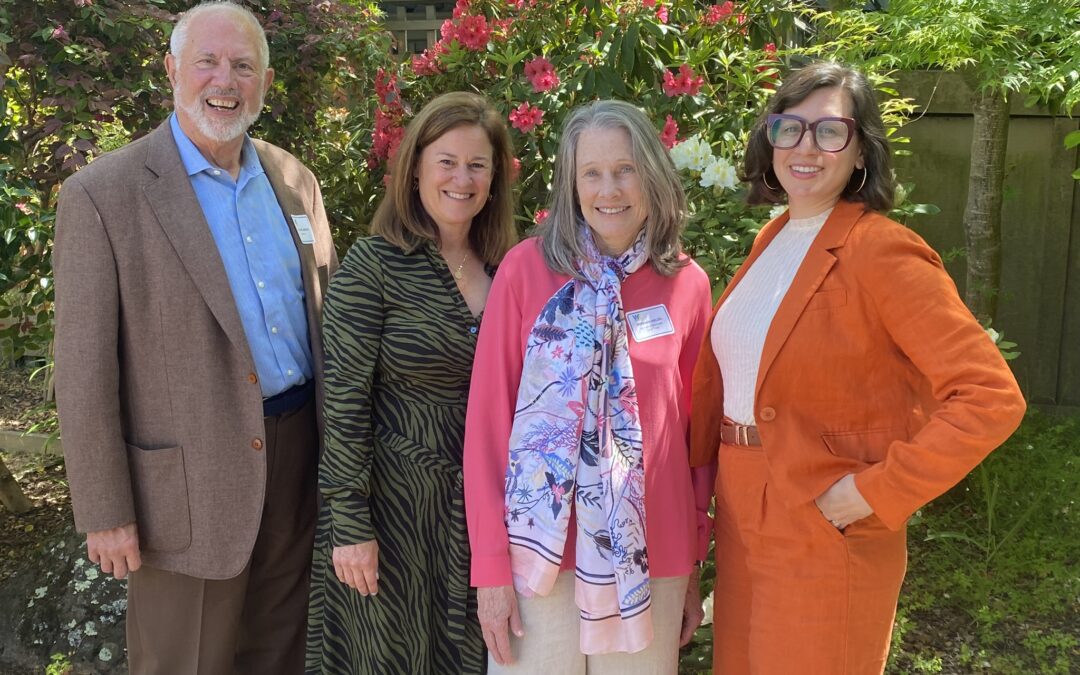
From left to right, longtime Marin IJ columnist and former Mill Valley Mayor Dick Spotswood, Marin Environmental Housing Collaborative’s Jennifer Silva, Rebekah Helzel from the Mt. Tam Community Land Trust and Bianca Newman from EAH Housing, which is spearheading the City of Mill Valley’s 40-unit affordable development at 1 Hamilton.
You have (hopefully) heard by now that Marin is in the midst of a housing crisis, and that if we don’t address it head on, we may ultimately lose the local control we have over where new housing appears within our community.
There have been no shortage of conversations around those subjects in recent years, but it’s clear that the most important piece is to keep talking about the need for a broader array of housing types that fit a multitude of income levels – and to identify as many additional properties as possible to address the need. To that end, Westminster Events – located at Westminster Presbyterian Church at 240 Tiburon Blvd. in Tiburon, once again gathered a group of knowledgeable folks for an information-driven discussion around ‘Affordable Housing in Marin: What You Need to Know,‘ featuring a quartet of engaged and informed local leaders on issues, insights and innovations.
The 90-minute discussion was moderated by longtime Marin IJ columnist and former Mill Valley Mayor Dick Spotswood and featured Bianca Newman from EAH Housing, which is spearheading the City of Mill Valley’s 40-unit affordable development at 1 Hamilton. The event also welcomed Rebekah Helzel from the Mt. Tam Community Land Trust and Jennifer Silva, a longtime housing advocate and the Board Chair for the Marin Environmental Housing Collaborative (MEHC).
Organizers for the event set the tone, indicating that while buying or renting in southern Marin was once feasible, in 2024, that’s no longer a reality for many. Today, many essential workers like first responders, teachers, nurses, and service employees commute daily. And for those with limited incomes, there are few options. Even many adults who grew up in Marin cannot afford to live here.
The over-arching specter of the conversation was making legitimate strides with California Department of Housing and Community Development and a certified Housing Element for years 2023-2031, long-term, state-mandated processes under the specter of ABAG’s Regional Housing Needs Allocation that calls for an eye-popping increase in the number of units to be planned for by the city, from 129 units in the 2014-2022 cycle to 865 units in 2023-2031. City Hall is required to plan for, but not necessarily build, 865 units within that time frame. The 1 Hamilton development is a major step forward but falls 825 units short of the long-term goal, and there are already plenty of complexities.
“Marin residents would love to support affordable housing, or at least that’s what they say,” Spotswood said at the outset. “To make real progress, we’re going to have to make larger strides.”
“It will take 15 years to build out of this crisis,” Silva said. “We haven’t been meeting these goals for 30-plus years. That’s why we have this level of homelessness. We need every kind of housing.” That could ADUs, also known as granny flats or in-law units.
The discussion took on an around-the-horn format with each guest answering the same questions. “Increasing housing density allows people to live closer to their jobs,” Silva said. “Walking and biking is best. Affordable housing really does bring a lot to your community,” and that includes teachers who would love to live closer to work.”
“Some 65% of our work force commutes into Marin,” Helzel said, and the number spikes to 70% in Mill Valley. “Density is much more environmentally sustainable, and affordable housing has really positive effects – increased positive outcomes with no negative impacts whatsoever to the existing population. People hear density and get really scared. But change is possible – we can build a few smaller units instead of building a monstrosity of a home. Churches with extra property (are possibilities).”
Neumann made clear the myriad challenges ahead. “1 Hamilton took three years to entitle,” she said. “We probably had a dozen public hearings on the project. The process needs to be consistent. This work can take a long time. But the biggest challenge we face locally is funding. Financing remains the biggest problem. Marin is facing some daunting challenges.”
“Interest rates are not what is holding Marin back,” Silva said. “Austin, Texas has the same interest rates as we do. Marin has had decades to do this. In Marin, the problem is ourselves.”
But there are some bright spots: the Bay Area Housing Finance Authority (BAHFA) is a regional public authority that works to create a Bay Area where there is enough safe, affordable and stable housing for all residents. BAHFA is working to bring immediate housing benefits to the region, including:
- A potential regional bond measure to generate $10 to $20 billion to build more affordable homes and help keep existing homes affordable.
- Current pilot programs and projects include: Doorway, an online affordable housing search and application portal that serves the nine counties, to simplify the process of finding affordable homes in the Bay Area.
- A rental assistance subsidy program in Napa to prevent extremely low-income seniors and people with disabilities from becoming homeless.
- One-time state grants for affordable housing preservation and production projects.
- A Bay Area affordable housing pipeline to provide a comprehensive inventory of affordable housing projects in pre-development in the region.
Silva noted that the County of Marin’s 2024 Legislative Platform provides the Board of Supervisors’ direction on Federal, State, and other intergovernmental legislative matters. That includes Homelessness and Affordable Housing Programs, which include:
- Protect/enhance funding for federal Housing and Urban Development (HUD) programs, including Community Development Block Grant (CDBG), the HOME Investment Partnerships Program, Continuum of Care and Section 8 vouchers.
- Support all efforts to increase Marin’s housing voucher allocation, including flexibility to reallocate underutilized vouchers from elsewhere.
- Support efforts to simplify rent-setting and enhance housing mobility and choice for veterans, older adults, families, and those experiencing chronic homelessness.
- Support greater flexibility in using federal vouchers and rapid-rehousing funds to best meet the unique needs of individuals seeking stable housing.
- Support efforts to streamline NEPA review for affordable housing when appropriate and feasible to ensure timely permitting of much-needed new housing.


What I am seeing from this report is an attempt to justify state led attempts to take over housing built in Marin County with very little regard for the citizens of our county. For instance Ms. Silva states that we haven’t met our goals for 30 years. In Mill Valley, all projects of multiple residences have had 20% affordable housing since the 1980’s. If that is not a laudable goal, I would like her to explain this statement. She states we have our current level of homelessness because we haven’t met goals that did not exist before 2000. Then she says we need every kind of housing. I do not think we need any more million dollar plus houses. Ms. Helzel states that density is much more environmentally sustainable and has no negative impacts. I would really like to know where that false information was found. Is she assuming the residents of Marin are so foolish as to believe such a statement? BAHFA is ABAG and MTC combined. This group is hardly a bright spot. ABAG is the association of bay area governments and MTC is the metropolitan traffic commission. The idea that this consortium works for safe and affordable housing is laughable at best. I do not think Marin residents are gullible enough to be fooled by this panel.